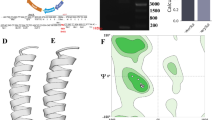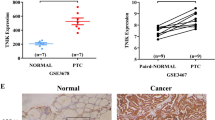Abstract
Pancreatic adenocarcinoma continues to be a devastating tumor (28,000 new cases per year in the United States; 10% 2-year survival). Pancreatic adenocarcinoma frequently (90% of the time) overexpresses fibroblast growth factor ligands (FGF-1 and FGF-2) and alternatively spliced high-affinity receptors (FGFR-lß) (FGFR-lct was previously found in normal pancreatic tissue). To study the significance of this observation in vitro, PANC-1 cells were stably transfected via the pMEXneo vector containing FGFR-la (PANC-la) or FGFR-lß (PANC-lß) isoforms. Cells were treated with 1 mg/ml of 5-fluorouracil. Cells were evaluated for growth inhibition, apoptosis (propidium iodide staining and flow cytometry, caspase 3 activation) and for Bcl-xL/BAX expression (by Western blot analysis). In vivo, 7 X 106 cells of each isoform were injected into nude Balb/c mice for xenograft formation (N = 10). Compared to PANC-lß (9%) in vitro, 5-fluorouracil-induced death was significantly (P < 0.05) increased in PANC-la (20%) at 24 hours. Increased cell death in PANC-la was mediated by activated caspase 3 and was correlated with decreased expression of Bcl-xL/BAX. In vivo, PANC-lß readily demonstrated formation of tumor xenograft at 2 weeks, whereas PANC-la did not form tumors. Alternative splicing of FGFR-1 to the ß isoform appears to correlate with pancreatic adenocarcinoma cell growth in vivo and resistance to chemotherapy. Inhibition of FGFR-1 splicing or overexpression of FGFR-la inhibits pancreatic adenocarcinoma cell growth in vivo and restores cytotoxic responses to chemotherapy, thereby suggesting the basis of rational interventional strategies for this devastating tumor.
Similar content being viewed by others
References
Janes,RH Jr,Niederhuber,JE,Chmiel,JS, et al. National patterns of care for pancreatic cancer. Results of a survey by the Commission on Cancer. Ann Surg 1996;223:261–272.
Song,S,Wientjes,MG,Gan,Y,Au,JL. Fibroblast growth factors: An epigenetic mechanisms of broad spectrum resistance to anticancer drugs. Proc Nat Acad Sci USA 2000; 97:8658–8663.
McKeehan,WL,Wang,F,Kan,M. The heparin sulfatefibroblast growth factor family: Diversity of structure and function. Prog Nucleic Acid Res Mol Biol 1998;59:135–176.
Yeo,CJ,Abrams,A,Gochow,LB, et al. Pancreaticoduodenectomy for pancreatic adenocarcinoma: Postoperative adjuvant chemoradiation improves survival. Ann Surg 1997; 225:621–636.
Leung,HY,Gullick,WJ,Lemoine,NR. Expression and functional activity of fibroblast growth factors and their receptors in human pancreatic cancer. Int J Cancer 1994;59:667–675.
Yamanaka,Y,Friess,H,Buchler,M, et al. Overexpression of acidic and basic fibroblast growth factors in human pancreatic cancer correlates with advanced tumor stage. Cancer Res 1993;53:5289–5296.
Friess,H,Yamanaka,Y,Buchler,M, et al. Increased expression of acidic and basic fibroblast growth factors in chronic pancreatitis. AmJ Pathol 1994;144:117–128.
Wagner,M,Lopez,ME,Cahn,M,Korc,M. Suppression of fibroblast growth factor receptor signaling inhibits pancreatic cancer growth in vitro and in vivo. Gastroenterology 1998;114:798–807.
Kornmann,M,Beger,HG,Korc,M. Role of fibroblast growth factors and their receptors in pancreatic cancer and chronic pancreatitis. Pancreas 1998;17:169–175.
Kim,I,Moon,SO,Yu,KH, et al. A novel fibroblast growth factor receptor-5 preferentially expressed in the pancreas (1). Biochim Biophys Acta 2001;1518:152–156.
Yamaguchi,F,Saya,H,Bruner,JM,Morrison,RS. Differential expression of two fibroblast growth factor-receptor genes is associated with malignant progression in human astrocytomas. Proc Nat Acad Sci USA 1994;91:484–488.
Luqmani,Y,Mortimer,C,Yiangou,C, et al. Expression of two variant forms of fibroblast growth factor receptor 1 in human breast. Int J Cancer 1995;64:274–279.
Opalenik,SR,Shin,JT,WehbyJN, et al. The HIV-1 TAT protein induces the expression and extracellular appearance of acidic fibroblast growth factor. J Biol Chem 1995;270:17457–17467.
Wigler,M,Sweet,R,Sim,GK, et al. Transformation of mammalian cells with genes from procaryotes and eucaryotes. Cell 1979; 16:777–785.
Chirgwin,JM,Przybyla,AE,MacDonald,RJ,Rutter,WJ. Isolation of biologically active ribonucleic acid from sources enriched in ribonuclease. Biochemistry 1979;18:5294–5299.
Smith,PK,Krohn,RI,Hermanson,GT, et al. Measurement of, protein using bicinchoninic acid [published erratum appears in Anal Biochem 1987;163:279.Anal Biochem 1985;150:76–85.
Wang,F,Kan,M,Yan,G, et al. Alternatively spliced NH2-terminal immunoglobulin-like loop I in the ectodomain of the fibroblast growth factor (FGF) receptor 1 lowers affinity for both heparin and FGF-1. J Biol Chem 1995;270:10231–10235.
Lin,HY,Xu,J,Ischenko,I, et al. Identification of the cytoplasmic regions of fibroblast growth factor (FGF) receptor 1 which play important roles in induction of neurite out-growth in PC12 cells by FGF-1. Mol Cell Biol 1998;18:3762–3770.
Curto,M,Frankel,P,Carrero,A,Foster,DA. Novel recruitment of Shc, Grb2, and Sos by fibroblast growth factor receptor-1 in v-Src-transformed cells. Biochem Biophys Res Commun 1998;243:555–560.
Weinstein,DC,Marden,J,Carnevali,F,Hemmati-Brivanlou,A. FGF-mediated mesoderm induction involves the Srcfamily kinase Laloo [published erratum appears in Nature 1998;395:921]. Nature 1998;394:904–908.
Landgren,E,Klint,P,Yokote,K,Claesson-Welsh,L. Fibroblast growth factor receptor-1 mediates chemotaxis independently of direct SH2-domain protein binding. Oncogene 1998;17:283–291.
Mao,W,Irby,R,Coppola,D, et al. Activation of c-Src by receptor tyrosine kinases in human colon cancer cells with high metastatic potential. Oncogene 1997;15:3083–3090.
Lutz,MP,Eber,IBS,Flossmann-Kast,BBM, et al. Overex-pression and activation of the tyrosine kinase Src in human pancreatic carcinoma. Biochem Biophys Res Commun 1998;243:503–508.
Yayon,A,Ma,YS,Safran,M, et al. Suppression of autocrine cell proliferation and tumorigenesis of human melanoma cells and fibroblast growth factor transformed fibroblasts by a kinase-deficient FGF receptor 1: Evidence for the involvement of Src-family kinases. Oncogene 1997;14:2999–3009.
Udayakumar,TS,Klein,RD,Maliner,MS, et al. Aberrant expression of fibroblast growth factor receptor-1 in prostate epithelial cells allows induction of promatrilysin expression by fibroblast growth factors. Int J Cancer 2001;91:187–192.
Cote,GJ,Huang,ES,Jin,W,Morrison,S. Sequence requirements for regulated RNA splicing of the human fibroblast growth factor receptor-1 alpha exon. J Biol Chem 1997;272:1054–1060.
Mercatante,D,Kole,R. Modification of alternative splicing pathways as a potential approach to chemotherapy. Pharmacol Ther 2000;85:237–243.
Jin,W,Huang,ES,Bi,W,Cote,GJ. Redundant intronic repressors function to inhibit fibroblast growth factor receptor-1 alpha-exon recognition in glioblastoma cells. J Biol Chem 1999;274:28035–28041.
Bansal,R,Kumar,M,Murray,K, et al. Regulation of FGF receptors in the oligodendrocyte lineage. Mol Cell Neurosci 1996;7:263–275.
Morrison,RS,Yamaguchi,F,Saya,H, et al. Basic fibroblast growth factor and fibroblast growth factor receptor I are implicated in the growth of human astrocytomas. J Neurooncol 1994;18:207–217.
Jin,W,Bi,W,Huang,ES,Cote,GJ. Glioblastoma cell-specific expression of fibroblast growth factor receptor-1 beta requires an intronic repressor of RNA splicing. Cancer Res 1999;59:316–319.
Jin,W,Huang,ES,Bi,W,Cote,GJ. Exon sequence is required for regulated RNA splicing of the human fibroblast growth factor receptor-1 alpha-exon. J Biol Chem 1998; 273:16170–16176.
Inada,T,Ichikawa,A,Igarashi,S, et al. Effect of preoperative 5-fluorouracil on apoptosis of advanced gastric cancer. J Surg Oncol 1997;65:106–110.
Aota,K,Azuma,M,Yamashita,T, et al. 5-Fluorouracil induces apoptosis through the suppression of NF-kappaB activity in human salivary gland cancer cells. Biochem Biophys Res Commun 2000;273:1 168–1174.
Ikebukuro,K,Adachi,Y,Toki,J, et al. Morphological change, loss of deltapsi(m) and activation of caspases upon apoptosis of colorectal adenocarcinoma induced by 5-FU. Cancer Lett 2000;153:101–108.
Green,DR,Reed,JC. Mitochondria and apoptosis. Science 1998;281:1309–1312.
Wolf,BB,Green,DR. Suicidal tendencies: Apoptotic cell death by caspase family proteinases. J Biol Chem 1999;274:20049–20052.
Thornberry,NA,Lazebnik,Y. Caspases: Enemies within. Science 1998;281:1312–1316.
Adams,JM,Cory,S. The Bcl-2 protein family: Arbiters of cell survival. Science 1998;281:1322–1326.
Walczak,H,Bouchon,A,Stahl,H,Krammer,PH. Tumor necrosis factor-related apoptosis-inducing ligand retains its apoptosis-inducing capacity on Bcl-2-or Bcl-xL-overex-pressing chemotherapy-resistant tumor cells. Cancer Res 2000;60:3051–3057.
Liu,R,Page,C,Beidler,DR, et al. Overexpression of Bclx(L) promotes chemotherapy resistance of mammary tumors in a syngeneic mouse model. Am J Pathol 1999;155:1861–1867.
Antonsson,B,Montessuit,S,Lauper,S, et al. Bax oligomerization is required for channel-forming activity in liposomes and to trigger cytochrome c release from mitochondria. BiochemJ 2000;345:271–278.
Eskes,R,Antonsson,B,Onsen-Sand,A, et al. Bax-induced cytochrome C release from mitochondria is independent of the permeability transition pore but highly dependent on Mg2+ ions. J Cell Biol 1998; 143:217–224.
Schlesinger,PH,Gross,A,Yin,XM, et al. Comparison of the ion channel characteristics of proapoptotic BAX and antiapoptotic BCL-2. Proc Nat Acad Sci USA 1997;94:11357–11362.
Antonsson,B,Conti,F,Ciavatta,A, et al. Inhibition of Bax channel-forming activity by Bcl-2. Science 1997;277:370–372.
Author information
Authors and Affiliations
Corresponding author
Additional information
Supported by grants RWJ 66390, NIH DK51629, and HL45990.
Rights and permissions
About this article
Cite this article
Vickers, S.M., Huang, ZQ., MacMillan-Crow, L. et al. Ligand activation of alternatively spliced fibroblast growth factor receptor-1 modulates pancreatic adenocarcinoma cell malignancy. J Gastrointest Surg 6, 546–553 (2002). https://doi.org/10.1016/S1091-255X(02)00036-7
Issue Date:
DOI: https://doi.org/10.1016/S1091-255X(02)00036-7




